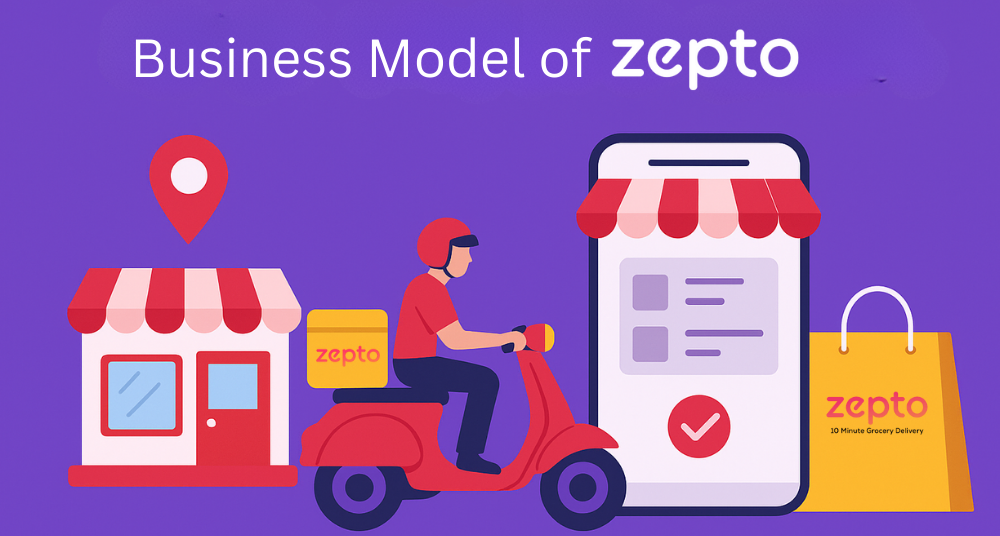Every big business starts with solving a small problem. For Zepto, that problem was simple: people hate waiting for groceries. In 2021, two young entrepreneurs decided to fix this by creating an app that delivers essentials in 10 minutes or less. Today, Zepto is a giant in India’s quick-commerce industry. But behind the fast deliveries is a smart business model that makes it all possible. Let’s explore Zepto Business Model and how it actually works.
How Zepto Became India’s Quick Commerce Star
Zepto’s success story is actually quite interesting. In 2021, two young boys, Aadit Palicha and Kaivalya Vohra, dropped out of Stanford University with a dream. They saw how people in Indian cities struggled with grocery shopping. Sometimes, you just need a packet of milk, some vegetables, or snacks, but even online delivery apps take 30–60 minutes or more. They asked themselves a simple question: “What if we could do this in just 10 minutes?”
To make this possible, Zepto built what are called dark stores. These are like small supermarkets, but not open for public shopping. They are placed in busy neighborhoods so that delivery riders are always close to customers. When an order comes, workers in the dark store quickly pick up the items, pack them, and a rider delivers them almost instantly.
This idea worked like magic. People were shocked to get groceries at their door in less than 10 minutes. Soon, Zepto expanded to many big cities like Mumbai, Delhi, Bengaluru, and Chennai. The speed, convenience, and reliability made it a favorite app, especially among young working professionals and families.
Today, Zepto is not just another grocery app — it’s one of India’s biggest quick commerce brands, showing how a small idea can grow into a billion-dollar business in just a few years.
Core Components of Zepto Business Model
Zepto’s success is not magic – it runs on a smart system. The company has built a model that makes sure groceries reach customers in just a few minutes. Let’s break down the key elements of Zepto’s model
1. Dark Stores (Mini Warehouses)
Zepto doesn’t deliver from big supermarkets. Instead, it sets up small warehouses called dark stores. These stores are placed in crowded areas of cities, so they are always close to customers. Each dark store is stocked with the most commonly needed items like milk, bread, snacks, vegetables, and household goods.
2. Limited Delivery Radius
Each dark store caters to customers within just a 2–3 km radius.This keeps the delivery route short, allowing riders to reach faster without traffic delays.
3. Smart Technology
Zepto uses technology to manage everything. From tracking which items are selling the most, to guiding delivery partners on the fastest route, everything is powered by apps and data. This reduces mistakes and saves time.
4. Delivery Fleet
Zepto has its own network of delivery riders. As soon as an order is placed, a rider nearby gets the notification, picks it up, and rushes to the customer’s home.
5. Fast Inventory Movement
Since demand is high and orders keep coming, stock in dark stores keeps moving quickly. This helps Zepto reduce waste and always keep fresh items ready.
How Zepto Makes Money
Zepto may deliver groceries fast, but speed alone doesn’t pay the bills. The company earns money in many smart ways. Here’s how:
1. Product Margins
Zepto buys groceries and household items in bulk from suppliers at a lower price. Then, it sells them to customers at regular market rates. The difference is its profit margin. This is similar to how supermarkets earn money, but Zepto does it faster and in smaller batches.
2. Delivery Charges
For small orders, Zepto adds a small delivery fee (like ₹10–₹30). Orders crossing a set minimum value often qualify for free delivery. These small charges add up to a big income when thousands of orders happen daily.
3. Zepto Pass (Subscription Plan)
Zepto also has a membership plan where customers pay a fixed amount every month or year. In return, they get benefits like free deliveries, discounts, and priority service. This not only brings extra income but also keeps customers loyal.
4. Advertising from Brands
If a company wants its product (like chips, soft drinks, or shampoo) to appear at the top of Zepto’s app, they pay for it. Just like ads in supermarkets or on shelves, Zepto earns money by giving brands premium space inside the app.
5. Private Labels
Zepto has started selling some of its own branded items. These products (like basic groceries and daily essentials) give higher profit margins because Zepto controls both the supply and the price.
6. Data Insights (Future Potential)
Since millions of people use the app, Zepto collects a lot of data on shopping habits. In the future, this data can be used to improve services or even sold as insights to brands for better marketing.
Marketing Secrets Behind Zepto’s Success
Zepto didn’t just grow fast because of its 10-minute promise — its smart marketing played a big role too. Instead of spending all its money on big TV ads, Zepto focused on connecting with young, urban customers directly through digital campaigns.
1. Word of Mouth & Curiosity
When Zepto first launched, people couldn’t believe groceries could arrive in just 10 minutes. This curiosity spread quickly, and customers started sharing their experiences with friends. That natural buzz gave Zepto free publicity.
2. Social Media Campaigns
Zepto ran fun, relatable ads on Instagram, YouTube, and Twitter that showed how fast and reliable their service is. Their catchy lines like “10-minute delivery” became their strongest brand identity.
3. Discounts and Free Delivery
To win over first-time users, Zepto rolled out attractive deals such as free delivery and major discounts. Once people tried the app and liked the speed, many of them stayed and became regular customers.
4. Targeting Young Professionals
Zepto focused on busy professionals and students who value time more than money. By understanding their lifestyle, the brand positioned itself as the fastest solution for last-minute needs.
5. Building Trust with Consistency
More than marketing slogans, Zepto gained trust by actually delivering on its 10-minute promise. That consistency turned first-time buyers into long-term loyal users.
SWOT Analysis of Zepto
Strengths of Zepto
- Ultra-Fast Delivery Promise – Zepto’s 10-minute delivery model sets it apart from traditional grocery apps.
- Strong Tech Infrastructure – Smart inventory management, dark stores, and route optimization ensure speed and accuracy.
- Youth Appeal – Its convenience and speed make it especially popular among urban professionals and students.
- Brand Recall – The “10-minute delivery” tagline has become a powerful identity.
- Wide Market Presence – Rapid expansion into metro cities like Mumbai, Delhi, Bengaluru, and Chennai.
Weaknesses of Zepto
- High Operating Costs – Running dark stores, paying delivery partners, and maintaining tech infrastructure is expensive.
- Thin Margins – The grocery business already has low profit margins, and discounts further cut into profits.
- Dependence on Urban Areas – The model works best in dense cities but is hard to scale in smaller towns.
- Customer Expectation Pressure – A slight delay in delivery can disappoint users accustomed to 10 minutes.
Opportunities for Zepto
- Expansion to New Cities – Huge potential in Tier-2 and Tier-3 cities as digital adoption grows.
- Private Label Products – Selling in-house brands can bring higher margins.
- Partnerships with FMCG Brands – Collaborations can boost advertising revenue and brand promotions.
- Technology Innovation – Using AI, automation, and predictive analytics can further optimize supply chain efficiency.
- Diversification of Services – Beyond groceries, Zepto could expand into medicines, daily essentials, and household products.
Threats to Zepto
- Intense Competition – Rivals like Blinkit, Swiggy Instamart, and BigBasket also dominate the quick-commerce space.
- Regulatory Risks – Labor laws, food safety checks, or restrictions on quick deliveries may slow operations.
- Sustainability Concerns – Questions about rider safety, high carbon footprint, and overworked delivery partners.
- Profitability Challenges – With discounts and free delivery, long-term profitability remains uncertain.
- Changing Consumer Behavior – If customers shift back to bulk-buying or supermarket shopping, demand may reduce.
This SWOT gives a 360° view of Zepto’s business model—both its strengths that fuel growth and the challenges that could impact its future.
Problems and Risks in Zepto Business Model
Even though Zepto has grown very fast, its journey is not without challenges. Running a business that promises 10-minute delivery sounds exciting, but it also brings many risks.
1. High Operating Costs
To keep dark stores running, pay delivery partners, and maintain technology, Zepto spends a lot of money. If orders slow down or discounts are too high, profits shrink quickly.
2. Thin Profit Margins
The grocery business itself does not have very high profits. Since Zepto adds free delivery and discounts to attract customers, it becomes even harder to stay profitable in the long run.
3. Heavy Competition
Zepto is not alone. Big players like Swiggy Instamart, Blinkit, and BigBasket also offer fast delivery. Competing with them means constant pressure to innovate and offer better deals.
4. Regulatory and Safety Issues
Dark stores and quick delivery services sometimes face checks from authorities for food safety, hygiene, and labor practices. Any strict rule can slow down Zepto’s operations.
5. Customer Expectations
Once people get used to 10-minute delivery, even small delays can make them unhappy. This high expectation adds daily pressure on riders and the system.
Final Words
Zepto’s journey from a bold idea to a leading quick-commerce brand shows how innovation, technology, and customer-first thinking can reshape an entire industry. By combining dark stores, smart logistics, and digital-first marketing, Zepto has redefined how urban India shops for essentials. While challenges like high costs, competition, and regulatory hurdles remain, its rapid growth proves the strength of its business model. As more people embrace speed and convenience, Zepto’s story offers valuable lessons for startups: solve a real problem, scale smartly, and deliver consistent value. In just a few years, Zepto has become India’s 10-minute delivery revolution.
Related Blog: How to Build a Delivery App Like Zepto
FAQs
1. What is Zepto business model?
Zepto operates on a quick-commerce model using dark stores, limited delivery radius, and smart logistics to deliver groceries in under 10 minutes.
2. How does Zepto make money?
Zepto earns through product margins, delivery charges, subscriptions (Zepto Pass), advertising, and private-label products.
3. What are dark stores in Zepto’s model?
Dark stores are small, tech-enabled warehouses located in busy neighborhoods that stock popular items for fast delivery.
4. Who founded Zepto?
Two Stanford dropouts, Aadit Palicha and Kaivalya Vohra, founded Zepto in 2021 with a bold idea.
5. What challenges does Zepto face?
High operating costs, thin profit margins, competition from rivals like Blinkit and Swiggy Instamart, and regulatory risks are its key challenges.
6. Why is Zepto popular among customers?
Its 10-minute delivery promise, reliability, and convenience make it especially popular among young professionals and families.






What do you think?
It is nice to know your opinion. Leave a comment.